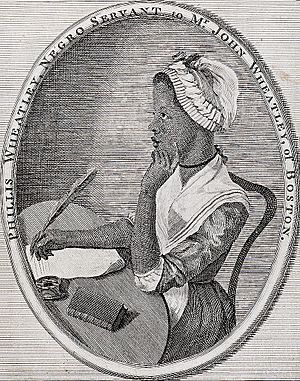Scipio Moorhead facts for kids

Scipio Moorhead was an African-American artist who lived a long time ago, around the 1770s. He lived in a city called Boston, Massachusetts. Scipio was an enslaved person, which means he was forced to work without pay and was not free. We know about him mostly because of a famous African-American poet named Phillis Wheatley. She wrote a poem especially for him, called "To S. M. a young African Painter, on seeing his Works." This poem was published in her book Poems on Various Subjects, Religious and Moral in 1773. We found out his full name from notes written in the margins of old books.
Contents
Who Was Scipio Moorhead?
Scipio Moorhead was an enslaved person belonging to Reverend John Moorhead, a religious leader in Boston. Even though he was enslaved, Scipio was very talented at drawing. Reverend Moorhead's wife, Sarah Moorhead, was an art teacher. She helped Scipio learn and improve his artistic skills. It was unusual for an enslaved person to have such opportunities. Scipio was even allowed to have some of the same rights as free workers. Sadly, none of Scipio's original artworks have survived to this day. However, some people think he might be the "negro artist" mentioned in a Boston newspaper in 1773. The newspaper described this artist as having "extraordinary genius."
Did Scipio Draw Phillis Wheatley's Portrait?
Many people wonder if Scipio Moorhead created the famous picture of Phillis Wheatley. This picture is a special type of drawing called a copperplate engraving. It appears at the front of many of her published poems. In the 1800s, Phillis Wheatley became very famous again, especially among people who wanted to end slavery. Many stories about her were shared, but Scipio Moorhead was not often mentioned.
Because of this, we are not completely sure if he drew her portrait. However, a scholar named William H. Robinson first suggested in 1984 that Scipio might have been the artist. This portrait is very special and different from other art of that time. It looks a bit like the work of a famous Boston painter named John Singleton Copley. But unlike Copley's paintings, this one shows a woman writing a poem and deep in thought. This was a new and exciting idea for a portrait. It was the first time an American woman writer was shown in a picture at the front of a book. It might even be the first picture ever of an American woman in the act of writing.
What Happened to Scipio?
In January 1775, Scipio was put up for sale as part of an estate sale. This means he was sold along with other belongings of his former owner. The sale took place near a famous spot called the Liberty Tree. Later, in the 1800s, people who fought against slavery were very upset that an enslaved person was sold in such a place.
In the 1780s, enslaved people in Massachusetts went to court and successfully won their freedom. This led to slavery being ended in Massachusetts. However, we do not know if Scipio Moorhead ever became free. The person who bought him was not recorded, and there are no records of where he went after 1775.
See also
- List of enslaved people

